Health Aids & Attendants
Featured schools near , edit
Types of Degrees Health Aids & Attendants Majors Are Getting
The following table lists how many health aids/attendants/orderlies graduations there were in 2021-2022 for each degree level.
| Education Level | Number of Grads |
|---|---|
| Basic Certificate | 1,607 |
| Undergraduate Certificate | 178 |
| Associate Degree | 33 |
What Health Aids & Attendants Majors Need to Know
People with careers related to health aids were asked what knowledge areas, skills, and abilities were important for their jobs. They weighted these areas on a scale of 1 to 5 with 5 being the highest.
Knowledge Areas for Health Aids Majors
Health Aids majors often go into careers in which the following knowledge areas are important:
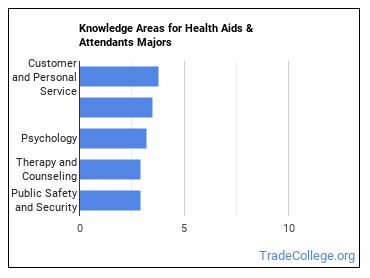
- Customer and Personal Service - Knowledge of principles and processes for providing customer and personal services. This includes customer needs assessment, meeting quality standards for services, and evaluation of customer satisfaction.
- English Language - Knowledge of the structure and content of the English language including the meaning and spelling of words, rules of composition, and grammar.
- Psychology - Knowledge of human behavior and performance; individual differences in ability, personality, and interests; learning and motivation; psychological research methods; and the assessment and treatment of behavioral and affective disorders.
- Therapy and Counseling - Knowledge of principles, methods, and procedures for diagnosis, treatment, and rehabilitation of physical and mental dysfunctions, and for career counseling and guidance.
- Public Safety and Security - Knowledge of relevant equipment, policies, procedures, and strategies to promote effective local, state, or national security operations for the protection of people, data, property, and institutions.
Skills for Health Aids Majors
health aids majors are found most commonly in careers in which the following skills are important:
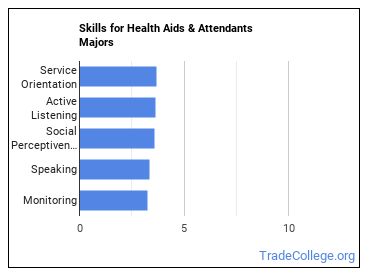
- Service Orientation - Actively looking for ways to help people.
- Active Listening - Giving full attention to what other people are saying, taking time to understand the points being made, asking questions as appropriate, and not interrupting at inappropriate times.
- Social Perceptiveness - Being aware of others’ reactions and understanding why they react as they do.
- Speaking - Talking to others to convey information effectively.
- Monitoring - Monitoring/Assessing performance of yourself, other individuals, or organizations to make improvements or take corrective action.
Abilities for Health Aids Majors
As you progress with your health aids degree, there are several abilities you should pick up that will help you in whatever related career you choose. These abilities include:

- Oral Comprehension - The ability to listen to and understand information and ideas presented through spoken words and sentences.
- Oral Expression - The ability to communicate information and ideas in speaking so others will understand.
- Problem Sensitivity - The ability to tell when something is wrong or is likely to go wrong. It does not involve solving the problem, only recognizing there is a problem.
- Speech Recognition - The ability to identify and understand the speech of another person.
- Speech Clarity - The ability to speak clearly so others can understand you.
What Can You Do With a Health Aids & Attendants Major?
Below is a list of occupations associated with health aids:
| Job Title | Job Growth Rate | Median Salary |
|---|---|---|
| Healthcare Support Workers | 11.7% | $37,830 |
| Home Health Aides | 47.3% | $24,200 |
| Nursing Assistants | 11.5% | $28,540 |
| Occupational Therapy Aides | 24.0% | $28,160 |
| Personal Care Aides | 38.6% | $24,020 |
| Physical Therapist Aides | 29.2% | $26,240 |
| Psychiatric Aides | 5.6% | $29,180 |
Who Is Getting an Associate’s Degree in Health Aids & Attendants?
Racial-Ethnic Diversity
At the countrywide level, the racial-ethnic distribution of health aids majors is as follows:
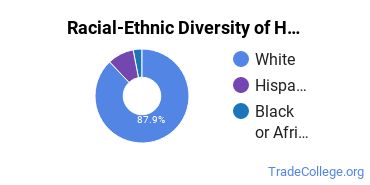
| Race/Ethnicity | Number of Grads |
|---|---|
| Asian | 0 |
| Black or African American | 3 |
| Hispanic or Latino | 0 |
| White | 27 |
| International Students | 0 |
| Other Races/Ethnicities | 3 |
How Much Do Health Aids & Attendants Majors Make?
Salaries According to BLS
Health Aids majors often go into careers where salaries can range from $25,330 to $32,580 (25th to 75th percentile). This range includes all degree levels, so you may expect those with a more advanced degree to make more while those with less advanced degrees will typically make less.
To put that into context, according to BLS data from the first quarter of 2020, the typical high school graduate makes between $30,000 and $57,900 a year (25th through 75th percentile). The average person with a bachelor’s degree (any field) makes between $45,600 and $99,000. Advanced degree holders make the most with salaries between $55,600 and $125,400.
Amount of Education Required for Careers Related to Health Aids & Attendants
Some careers associated with health aids require an advanced degree while some may not even require a bachelor’s. Whatever the case may be, pursuing more education usually means that more career options will be available to you.
Find out what the typical degree level is for health aids careers below.
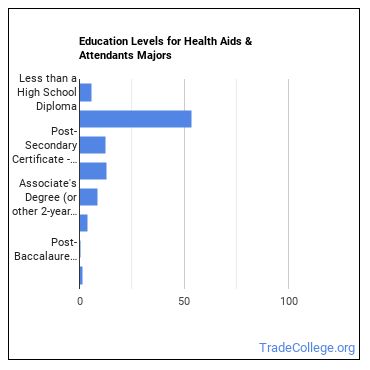
| Education Level | Percentage of Workers |
|---|---|
| Less than a High School Diploma | 5.8% |
| High School Diploma - or the equivalent (for example, GED) | 53.7% |
| Post-Secondary Certificate - awarded for training completed after high school (for example, in agriculture or natural resources, computer services, personal or culinary services, engineering technologies, healthcare, construction trades, mechanic and repair technologies, or precision production) | 12.5% |
| Some College Courses | 12.9% |
| Associate’s Degree (or other 2-year degree) | 8.8% |
| Bachelor’s Degree | 3.7% |
| Post-Baccalaureate Certificate - awarded for completion of an organized program of study; designed for people who have completed a Baccalaureate degree but do not meet the requirements of academic degrees carrying the title of Master. | 0.1% |
| Master’s Degree | 1.5% |
Online Health Aids & Attendants Programs
The following table lists the number of programs by degree level, along with how many schools offered online courses in the field.
| Degree Level | Colleges Offering Programs | Colleges Offering Online Classes |
|---|---|---|
| Certificate (Less Than 1 Year) | 0 | 0 |
| Certificate (1-2 years) | 36 | 0 |
| Certificate (2-4 Years) | 0 | 0 |
| Associate’s Degree | 8 | 0 |
| Bachelor’s Degree | 0 | 0 |
| Post-Baccalaureate | 0 | 0 |
| Master’s Degree | 0 | 0 |
| Post-Master’s | 0 | 0 |
| Doctor’s Degree (Research) | 0 | 0 |
| Doctor’s Degree (Professional Practice) | 0 | 0 |
| Doctor’s Degree (Other) | 0 | 0 |
Is a Degree in Health Aids & Attendants Worth It?
The median salary for a health aids grad is $29,580 per year. This is based on the weighted average of the most common careers associated with the major.
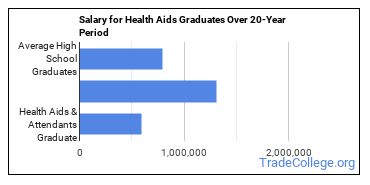
Explore Major by State
Alabama
California
District of Columbia
Idaho
Kansas
Maryland
Mississippi
Nevada
New York
Oklahoma
South Carolina
Utah
West Virginia
Alaska
Colorado
Florida
Illinois
Kentucky
Massachusetts
Missouri
New Hampshire
North Carolina
Oregon
South Dakota
Vermont
Wisconsin
Trades Related to Health Aids & Attendants
You may also be interested in one of the following majors related to health aids.
| Major | Number of Grads |
|---|---|
| Health & Medical Administrative Services | 88,600 |
| Practical Nursing & Nursing Assistants | 85,339 |
| Allied Health Professions | 83,905 |
| Allied Health & Medical Assisting Services | 83,587 |
| Health Sciences & Services | 36,762 |
| Mental & Social Health Services | 30,331 |
| Dental Support Services | 26,024 |
| Clinical/Medical Laboratory Science | 18,884 |
| Somatic Bodywork & Therapeutic Services | 10,622 |
| Ophthalmic & Optometric Support Services | 817 |
| Energy & Biologically Based Therapies | 89 |
References
*The racial-ethnic minorities count is calculated by taking the total number of students and subtracting white students, international students, and students whose race/ethnicity was unknown. This number is then divided by the total number of students at the school to obtain the racial-ethnic minorities percentage.
- College Factual
- College Scorecard
- National Center for Education Statistics
- O*NET Online
- U.S. Bureau of Labor Statistics
- Usual Weekly Earnings of Wage and Salary Workers First Quarter 2020
More about our data sources and methodologies.
Featured Schools
 Request Info
Request Info
|
Southern New Hampshire University You have goals. Southern New Hampshire University can help you get there. Whether you need a bachelor's degree to get into a career or want a master's degree to move up in your current career, SNHU has an online program for you. Find your degree from over 200 online programs. Learn More > |
